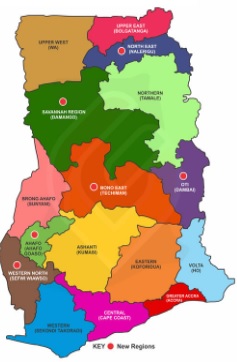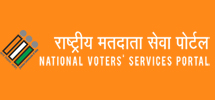| GENERAL |
| Official Name |
Republic of Ghana |
Location |
On the West Coast of Africa, situated between latitudes 4° and 11° North, bordered by Togo on the east, Côte D’Ivoire on the West, Burkina Faso on the North and the Atlantic Ocean on the South. |
| Capital |
Accra |
Regions |
16 (Greater Accra, Western, Central, Eastern, Volta, Ashanti, Bono, Northern, Upper West, Upper East, Ahafo, Bono East, Savannah, North East, Oti and Western North). Last 6 regions created in 2018. Regions are headed by Regional Ministers appointed by the President. |
| Area |
238,533 km2. (Land: 227,533 km2; Water: 11,000 km2) |
Climate |
Ghana is characterized by a tropical climate. The annual rainfall level decreases as the altitude increases to the north, where Savannah climate becomes dominant. Most part of the country belongs to the Tropical Savannas climate and the Sub-Sahelian African moist region. The annual mean temperature ranges from 25°C to 27°C and is fairly constant throughout the year. The annual rainfall can be as high as 2,000mm in the south-western part of the country & decreases towards the north-east, dropping to 1,000mm at the northern border area.
|
| Population |
30.83 million (Male: 15.2mn; Female: 15.6mn) (Ghana PHC, 2021) |
| Age Profile |
0-14 (35.3%); 15-64 (60.4%), 65 & above (4.3%) |
| Life Expectancy |
64.9 years (Male 63.8 years; female 66.1 years) |
| Languages |
English; Major local dialects: Akan (or Twi), Ewe, Dagbani, Nzema and Ga/Adangbe. In all, there are about 60 different languages. |
| Ethnic Groups |
Akan 45.7%, Mole-Dagbani 18.5%, Ewe 12.8%, Ga-Dangme 7.1%, Gurma 6.4%, Guan 3.2%, Grusi 2.7%, Mande 2%, other 1.6% (2021e) |
| Religion |
Christian 71.3% (Pentecostal/Charismatic 31.6%, Protestant 17.4%, Catholic 10%, other 12.3%), Muslim 19.9%, traditionalist 3.2%, other 4.5%, none 1.1% (2021 est.) |
| Internet Penetration |
71.94% (Jun 2023). Total data subscriptions: 22.08mn. |
| Mobile Phones |
Total voice subscriptions was 39,812,171 (Jan. 2023) |
| Urbanisation |
58.62% (2021, WB) |
| Forest area |
7.9mn hectares, 35.1% of total land area (FAO, 2020) |
| POLITICAL |
| Political Structure |
Unitary Republic; Constitutional democracy |
Major Political Parties |
Ruling New Patriotic Party (NPP) and opposition National Democratic Congress (NDC); others are Convention People’s Party (CPP)
In the Parliamentary elections in December 2020, out of 275 seats, the NPP and the NDC won 137 seats each, with one secured by an independent, who extended support to NPP. |
| Head of State |
President (H.E. Mr. Nana Addo Dankwa Akufo-Addo since 7 January 2017; re-elected for 2nd term winning the Presidential elections in December 2020, securing 51.6% votes) |
| Head of Government |
Presidential Form of Government |
| Political Structure |
Unitary Republic; Constitutional Democracy |
| ECONOMIC |
| Currency |
Cedis (1 Cedi=100 pesewas; USD1=GhC 11.00) (May 2023) |
| GDP |
USD 68.3bn (current); US$ 5503.57 (PPP) (2022, WB) |
| GDP Per Capita |
USD 2,175.9 (currrent-2022, WB) |
| GDP Growth Rate |
1.3% (annual - 2022, WB) |
| Composition of GDP |
Agriculture (19.71%); Industry (28.26%); Services (45.93%)
(Statista, 2021). |
| Inflation |
43.1% (July 2023, GSS) |
| External debt |
USD 29.3bn (June 2023, BOG) |
| Unemployment |
3.9% (2022, WB) |
Trade with World |
Total: GH¢292.7bn (USD 35.21bn)
Exports: GH¢144.1bn (USD 17.33bn)
Imports: GH¢148.6bn (17.88bn)
[GSS data in Cedi converted @USD1=GH¢8.3109 (2022)] |
| FDIs net inflows |
USD 1.116 billion (2022, GIPC) |
| Net ODAs received |
USD 1227.42 (2021, WB) |
| BILATERAL TRADE |
Total Trade |
USD 723.03mn (2023-24 Apr-Jun); USD 2,873.76mn (2022-23)
[USD 2,607.24mn (2021-22); USD 2,237.46mn (2020-21), USD 2,390.97mn (2019-20); USD 4,480.74mn (2018-19)] (DoC, GoI) |
India’s Exports |
USD 222.93mn (2023-24 Apr-Jun); USD 964.17mn (2022-23)
[USD 1109.66mn (2021-22); USD 862.50mn (2020-21); USD 617.42mn (2019-2020); USD 717.33mn (2018-19)] (DoC, GoI)
Pharmaceutical, Mineral Fuels & Oils, Plastics & articles, Iron or Steel & articles, Vehicles & parts, Textile, Chemicals, Cereals, Paper & Paperboard, etc. |
India’s Imports |
USD 500.10mn (2023-24 Apr-Jun); USD 1,909.59mn (2022-23)
[USD 1,497.77mn (2021-22); USD 1,374.96mn (2020-21); USD 1,773.55mn (2019-2020); USD 3,763.41mn (2018-19). (DoC, GoI)
Gold, Edible fruit and nuts, Wood, Oil seeds and Olea, Aluminium, Rubber, Cocoa, Iron and Steel, etc. |
India’s FDIs in Ghana |
USD 10.8mn in 5 projects in 2023 (Jan-Jun); USD 32.48mn in 25 projects in 2022.
[USD 2.2bn between 1994-2021. USD 93.84mn in 25 projects in 2021; USD 34.87mn in 11 projects in 2020; USD 17.49mn in 16 projects]. (GIPC)
Agriculture, pharmaceuticals, construction, manufacturing, agro-processing, service, tourism, etc. |
| Ghana’s FDIs in India |
As per data available with DIPP, FDI inflow from Ghana is negligible. US$ 7.78mn from Apr 2020-Sep 2021. (DPIIT, GoI) |
Indian Community |
The estimated number of Indians living in Ghana is about 15,000 out of which about 3,000 hold Ghanaian nationality. Some of the PIOs have been in Ghana for over 70 years. Majority of the older generation of PIOs are Gujaratis and Sindhis. The business activities of Indians in Ghana have contributed in a major way to the economic development of Ghana and is well appreciated. The NRIs in Ghana are mainly middle level employees of companies operating in Ghana, both Indian-origin owned as well as foreign companies, particularly in IT, marketing, finance and accounts, etc.
|

















